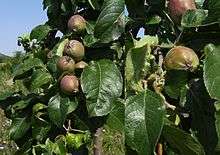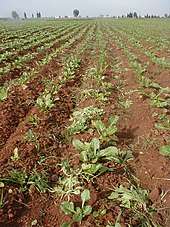Thinning
Thinning is a term used in agricultural sciences to mean the removal of some plants, or parts of plants, to make room for the growth of others but does not involve the cutting of the whole tree. Selective removal of parts of a plant such as branches, buds, or roots is typically known as pruning.

In forestry, thinning is the selective removal of trees, primarily undertaken to improve the growth rate or health of the remaining trees. Overcrowded trees are under competitive stress from their neighbors. Thinning may be done to increase the resistance of the stand to environmental stress such as drought, insect infestation, extreme temperature, or wildfire.[1][2]
In forestry
.jpg)
This may be done to make the stand more profitable in an upcoming final felling or to achieve ecological goals such as increasing biodiversity or accelerating the development of desired structural attributes such as large diameter trees with long tree crowns.
Early thinning, say after 20 years rather than late thinning, say after 50 years has different effects on the trees thinned. An early thinning would encourage trees to get wider crowns, increase diameter and be more stable against threats like snow breakage or windthrow. Too much too early would lead to a site overgrowing with shrubs and prevent an understory regenerating effectively. Doing it too late would mean that trees would grow tall and slender and though some increment would come to the trees, they may be less marketable as thinness reduces value. Too early and epicormic shooting is a risk, and this can lead to tree branchiness and knots in the resultant timber harvest, again reducing value.
Traditionally thinning has been done to create a desired balance between individual tree attributes (such as tree diameter) and per area attributes such as volume.[3] It has been, and often still is, applied with the desire to create uniform stands. Thinning treatments are often described in terms of number of trees per area to remain or average spacing between trees. The intent is to create and manage uniform stands. It is also more needed when too many trees were initially planted or survived from the seedling phase. Planting less and thinning less saves money in commercial forestry, so a good balance is required and is dependent on site qualities as well as planting régimes.
There is no sure result from thinning and no standard timing or other aspect. Individual site conditions and species responses or species mixes on sites may vary considerably and thus responses to thinnings likewise. Norway spruce on a suitable site have responded well in terms of growth increment, to late thinnings (after 50 years)[4] whereas other species have not for example slash pine.[5]
Due to such variability it is better to talk about a thinning régime rather than one particular method of thinning taking place in a stand.
Thinning methods
- thinning from below – this low thinning can be split into 4 Grades: A Grade is a very light thinning, that removes all overtopped trees Kraft crown class 4 and 5. B Grade is a very light thinning that removes overtopped trees and intermediates which are Kraft Crown class 4,5 and some 3s, C Grade and D Grade are a moderate and heavy thinning respectively removing anything that will not lead to high quality tree crown growth.
- thinning from above – this crown thinning removes all of the trees that impact crown wise on other trees. Smaller trees, Kraft crown class 5 for example would just be ignored and left in the stand and not cut. It is also called the French method.[6]
- diameter-limit thinning this selection thinning is related to the Borggreve silvicultural system. Large trees over a certain diameter are removed for smaller trees in good condition to grow. These in turn after some growth are thinned. Eventually the stand is exhausted after several cycles and the remnant is clear cut and replanted. It is used with shade tolerant species like Western hemlock.
- geometrical thinning – mechanical thinning like this is used in plantations where one row is taken out and the next left no matter the tree condition. A different grid might be used for natural stands sometimes called strip thinning.
- free thinning – this is done as crop tree release and it means thinning around a wanted tree, over a stand this may mean in some areas no thinning and in others a lot of thinning. this heterogeneity represents where the most valuable trees are.[7]
Ecological thinning
A thinning in which the trees removed have little or no economic value is called a pre-commercial thinning. Ecological thinning is a variant of this being studied for use in forest conservation. The primary aim of forest thinning is to increase growth of selected trees, but ecological thinning is done to favor development of wildlife habitat (such as hollows) rather than focusing on increased timber yields. Thinning may also reduce the risk of wildfire by increasing availability of groundwater as well as reducing fuel for wildfires.[2]
Chemical thinning is a form of non-commercial thinning in which the trees are killed while they stand by injecting a chemical such as glyphosate (Round Up) into a cut made in the stem. This reduces the number of live stems remaining, providing a benefit to those that remain and may be undertaken where the cost of a traditional thin is high. It can also be done on very exposed sites where breaking the canopy through a traditional thinning operation would expose the stand to a high risk of windthrow.
Another type of thinning is called variable density thinning. In this type of thinning, the intent is to manage various portions of the stand in different ways to create structural and spatial heterogeneity. The intent is often to increase biodiversity or wildlife habitat. In variable density thinning, some portions of the stand may not be entered. These unentered areas, sometimes called reserves, leave islands, or skips (as they are skipped over) help retain a large range of tree diameters, serve as a future source of competition-related mortality, and may preserve snags, down wood, and understory plants.
Other portions of a stand could be heavily thinned or gaps or openings could be created. These areas accelerate the growth rates of trees in the open areas or on their perimeter and help retain or develop long crowns with live branches. Another portion of the stand, sometimes referred to as the matrix, is thinned to result in residual trees densities which area in between the other extremes. Over the whole area, a wide variety of trees with different diameters and species are retained.
Virtual thinning in marteloscopes
Timber marking - selecting the trees to be cut in a forest stand by marking them - is a crucial task for a forest manager. Because of the irreversible character of cutting trees, tools were developed to virtually practice tree selection. A marteloscope is a forest site (typically a one hectare rectangular site) where all trees are numbered, mapped and recorded. This information can then be visualised through an application on a hand-held device such as a tablet.[8]
In agriculture

What are the objectives of thinning versus non thinning in carrot productionIngriculture and gardening, thinning is the selective removal of flowers, fruits, shoots, and seedlings or young plants to allow adequate space for the remaining organs/plants to grow efficiently. In large-scale farming, techniques like precision seeding and transplanting can eliminate the need for thinning by starting plants at their optimum spacing. On a smaller scale, such as a home vegetable garden, thinning can be used as a way to make maximum use of space for certain crops. For example, beets, carrots, green onions and others can be planted densely, and then thinned to make room for continued growth of the plants left in the soil, and also as a harvest of baby vegetables (beet greens, baby carrots, baby onions). Also thinning is used in post harvesting.
See also
References
- "Ecological Restoration vs. Thinning". Northern Arizona University. Archived from the original on September 1, 2006.
- "In California's forests, removing small trees leaves water for bigger ones and for dwindling reservoirs". The Economist. 2016-12-17. ISSN 0013-0613. Retrieved 2016-12-19.
- Smith et al. 1997
- Responses from thinning a 50 year old Norway spruce plantation in central New York, SUNY Coll. Enviro. Sci. & Forestry Sch. Tech. Publication No. 1 (ESF 85-002) Drew, AP 1985
- Thinning practices in short-rotation stands. In A.B. Crow (Ed.), Advancement in management of Southern pines pg 50-60 10th Ann Forerst Symposium Baton Rouge LA. State UniPress 1961
- Baker, Frederick. Theory and Practice of Silviculture. First Edition. New York: McGraw-Hill, 1934. Print.
- Silviculture Concepts and Applications, Ralph D. Nyland 2002 Chapter 18 Methods of Thinning
- "Marteloscopes and data". iplus.efi.int/. Informar. Retrieved 10 March 2020.